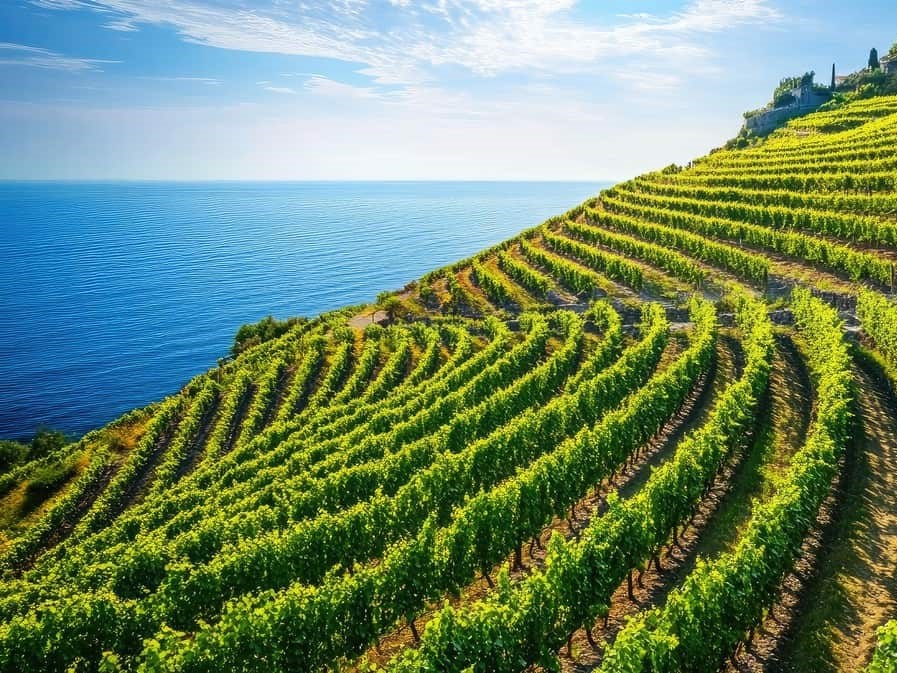
 We the Italians Editorial Staff
We the Italians Editorial Staff
Italian wine: Ligurian wines, a legacy carved by sea, stone and tradition
- WTI Magazine #190 Aug 09, 2025
-

 We the Italians Editorial Staff
We the Italians Editorial Staff
In Liguria, a narrow strip of land nestled between the mountains and the Mediterranean Sea in northwestern Italy, wine production is as much about geography as it is about tradition. The region’s steep coastal cliffs and terraced vineyards, often with no road access, define what many call “heroic viticulture.” Grapes are harvested by hand, often carried in baskets on the shoulders of workers navigating rocky paths that plunge toward the sea. This challenging environment, constantly kissed by salty sea breezes, gives Ligurian wines a distinctive character found nowhere else.
With only 1,500 hectares under vine, Liguria’s wine industry is small but mighty. Around 65% of vineyards are located in mountainous areas, 34% on hills, and just 1% on flat land. Annual production hovers around 46,000 hectoliters, with 79% of the wines classified as DOP (Denominazione di Origine Protetta) and 9% as IGP (Indicazione Geografica Protetta). White wines dominate production at 65%, while reds and rosés make up the remaining 35%.
Liguria’s viticulture is shaped by the region’s unique topography and Mediterranean climate. Combined with a deep commitment to native grape varieties, these factors make Ligurian wines stand out from those of neighboring regions. Grapes like Vermentino, Pigato, and Rossese have adapted over centuries to Liguria’s demanding terrain and salty, sun-drenched air, producing wines that reflect the authenticity and complexity of the local terroir.
The history of winemaking in Liguria is ancient and storied. Evidence suggests that both the Etruscans and the Greeks were cultivating vines along this coastline well before the rise of the Roman Empire. The Greeks brought sophisticated viticultural practices and new grape varieties, laying the groundwork for a wine culture that flourished under Roman rule. Recognizing the area’s potential, the Romans expanded vineyard plantings and improved winemaking methods, integrating wine deeply into everyday life and ritual.
During the Middle Ages, it was the monastic orders that preserved and enhanced Ligurian viticulture. Monasteries became centers of agricultural innovation, with monks meticulously tending the vines and refining winemaking processes. The Renaissance saw a resurgence in Ligurian wine’s reputation, aided by the powerful maritime republic of Genoa, which enabled exports throughout Europe and the Mediterranean.
Today, Liguria is known for its small-scale wineries, many of them family-run, that continue to prioritize native grapes and time-honored methods. Harvesting is still done by hand, a necessity in many parts of the region due to the rugged terrain. This painstaking approach yields wines with bright acidity, floral aromatics, and layered minerality - qualities that have come to define the region’s output.
Most of Liguria’s wine production takes place along the coast, as the inland areas are dominated by mountains. White grape varieties are most prevalent in the central and eastern parts of the region, while black-skinned grapes are more commonly grown in the west. The flagship white grape is Vermentino, prized for its freshness and citrusy notes, while the top red is Rossese, a low-pigment grape reminiscent of Nebbiolo in its delicate complexity. Other white grapes include Pigato, Bosco, and Albarola; reds include Ormeasco (a local clone of Dolcetto), Barbera, and Ciliegiolo, particularly prominent in the central and eastern areas.
One of the most iconic winegrowing areas in Liguria is the Cinque Terre, a stunning coastal stretch known for its vertical vineyards overlooking the sea. Here, the famed Cinque Terre DOC white wine is made - a crisp, mineral-rich expression of the rugged coastline. The area also produces Sciacchetrà, a golden-hued, aromatic dessert wine made from sun-dried grapes - a true rarity and a local treasure.
To the west of Genoa lies the Riviera Ligure di Ponente, extending all the way to the French border. This area is especially known for Pigato, a white wine with a citrusy, herbal profile and a marked mineral edge. Vermentino also thrives here, along with Rossese di Dolceacqua, a light, fruity red that pairs beautifully with the region’s seafood-driven cuisine.
At the southeastern edge of the region, where Liguria meets Tuscany, are the Colli di Luni, a wine zone offering a compelling blend of Ligurian and Tuscan influence. Vermentino reigns here as well, showing a range from fresh and floral to full-bodied and structured. Red wines like Ciliegiolo and Sangiovese are also produced, known for their spicy, fruit-forward character.
Closer to Genoa, the Golfo del Tigullio and Portofino DOC offer a selection of whites and reds. White wines here are often made from Vermentino and Bianchetta Genovese, offering gentle aromatics and light, refreshing palates. The reds, crafted from Dolcetto and Rossese, are ideal companions to both land and sea dishes typical of Ligurian cuisine.
Finally, in the Val Polcevera, located in the hinterland near Genoa, lies one of Liguria’s lesser-known designations: Coronata Val Polcevera DOC. This white wine, primarily made from Bianchetta Genovese, is notable for its bright acidity and saline finish - an elegant, under-the-radar expression of Liguria’s viticultural soul.
Liguria’s wines may not be produced in large volumes, but they offer a vivid taste of place - shaped by steep cliffs, salty winds, and centuries of craftsmanship. For wine lovers seeking something truly unique, this narrow coastal region delivers bottles as memorable as its breathtaking landscapes.